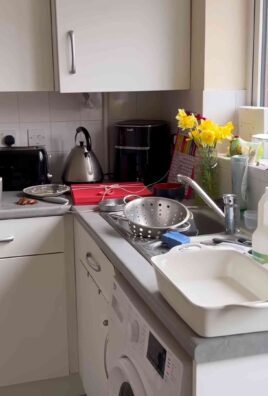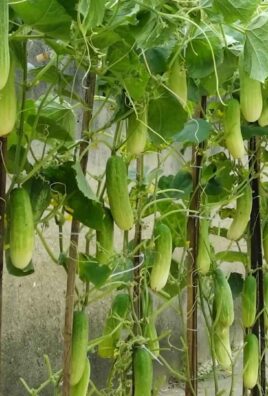Grow vegetables at home cheap? Absolutely! Imagine stepping into your backyard and harvesting fresh, flavorful vegetables for tonight’s dinner, all without breaking the bank. For centuries, people have cultivated their own food, from ancient Roman kitchen gardens to the victory gardens of World War II. This connection to the earth, and the satisfaction of nurturing life, is deeply ingrained in us.
But let’s be honest, the idea of starting a garden can feel overwhelming, especially when you see those price tags at the garden center. That’s where this DIY guide comes in! I’m going to share some of my favorite tried-and-true tricks and hacks to help you grow vegetables at home cheap. We’ll explore resourceful ways to source materials, clever planting techniques, and simple solutions to common gardening challenges.
Why do you need these DIY tricks? Because everyone deserves access to fresh, healthy food, regardless of their budget. Plus, gardening is incredibly therapeutic! So, let’s ditch the expensive store-bought produce and embark on a rewarding journey of creating your own thriving, budget-friendly vegetable garden. Get ready to get your hands dirty and discover the joy of homegrown goodness!

DIY Budget-Friendly Home Vegetable Garden
Hey there, fellow gardening enthusiasts! Want to enjoy fresh, homegrown veggies without breaking the bank? You’ve come to the right place! I’m going to walk you through creating a thriving vegetable garden on a shoestring budget. Trust me, it’s easier (and more rewarding) than you think!
Planning Your Garden: Location, Location, Location!
Before you even think about seeds, let’s figure out where your garden will live. This is crucial for success!
* Sunlight is Key: Most vegetables need at least 6 hours of direct sunlight per day. Observe your yard throughout the day to identify the sunniest spots. South-facing areas are usually ideal.
* Water Access: You’ll need a water source nearby. Lugging watering cans across the yard gets old fast! Consider a hose or even a rain barrel.
* Soil Quality: Healthy soil is the foundation of a healthy garden. We’ll talk about improving it on a budget later.
* Size Matters: Start small! It’s better to have a small, well-maintained garden than a large, overgrown one. A 4×4 foot raised bed or a few containers is a great starting point.
* Accessibility: Make sure your garden is easy to access for planting, weeding, and harvesting.
Choosing Your Vegetables: What to Grow?
Now for the fun part! Think about what you actually *like* to eat. There’s no point in growing kale if you’re not a fan!
* Easy Beginners: Some vegetables are easier to grow than others, especially for beginners. Consider these:
* Lettuce
* Radishes
* Spinach
* Green beans
* Zucchini
* Tomatoes (determinate varieties are easier)
* Peppers
* Consider Your Climate: Different vegetables thrive in different climates. Check your local planting calendar to see what grows well in your area and when to plant it.
* Space Requirements: Some vegetables, like pumpkins and watermelons, need a lot of space. Others, like herbs and radishes, can be grown in small containers.
* Succession Planting: Plant crops that mature quickly (like radishes and lettuce) every few weeks to ensure a continuous harvest.
* Budget-Friendly Options: Growing from seed is much cheaper than buying transplants.
Building Your Garden Beds: DIY on a Dime
You don’t need fancy raised beds to grow vegetables. Here are some budget-friendly options:
* Repurposed Materials: Use old pallets, cinder blocks, or even tires to create raised beds. Just make sure the materials are safe and haven’t been treated with harmful chemicals.
* No-Dig Gardening: This method involves layering organic materials directly on top of the ground, eliminating the need for digging. It’s great for improving soil quality and reducing weeds.
* Container Gardening: Use pots, buckets, or even old laundry baskets to grow vegetables. Make sure the containers have drainage holes.
* In-Ground Gardening: If your soil is decent, you can simply plant directly in the ground.
Step-by-Step Guide to Building a Pallet Raised Bed
I love using pallets because they’re often free and readily available. Here’s how to turn them into a raised bed:
1. Source Your Pallets: Look for pallets that are heat-treated (HT) rather than chemically treated (MB). You can usually find this information stamped on the pallet. Avoid pallets that have been used to transport chemicals or hazardous materials. Hardware stores, construction sites, and landscaping companies are good places to ask.
2. Disassemble the Pallet (Optional): You can use the pallet as is, or disassemble it for individual boards. Disassembling gives you more flexibility in design, but it’s more work. Use a pry bar and hammer to carefully remove the boards. Wear gloves to protect your hands.
3. Build the Frame: If you disassembled the pallet, use the boards to build a rectangular frame. You can use screws or nails to attach the boards together. Make sure the frame is sturdy. If you’re using the pallet as is, you may need to reinforce the corners with additional wood.
4. Line the Bed: Line the inside of the bed with landscape fabric or cardboard to prevent soil from leaching out. This also helps to suppress weeds.
5. Fill with Soil: Fill the bed with a mixture of topsoil, compost, and other organic matter.
Soil Improvement: Feeding Your Plants on a Budget
Healthy soil is essential for healthy plants. Here’s how to improve your soil without spending a fortune:
* Composting: Composting is a great way to recycle kitchen scraps and yard waste into nutrient-rich soil amendment. You can build your own compost bin or simply pile the materials in a corner of your yard.
* Cover Crops: Plant cover crops like clover or rye in the fall to improve soil structure and add nutrients.
* Free Amendments: Coffee grounds, eggshells, and grass clippings can all be used to improve soil quality.
* Local Resources: Check with your local municipality for free or low-cost compost or mulch.
Planting Your Vegetables: From Seed to Harvest
Now for the moment you’ve been waiting for!
1. Starting Seeds Indoors (Optional): Starting seeds indoors gives you a head start on the growing season. Use seed starting trays or small pots filled with seed starting mix. Sow the seeds according to the package directions. Keep the soil moist and provide plenty of light.
2. Direct Sowing: Some vegetables, like radishes and carrots, are best sown directly in the garden. Prepare the soil by loosening it and removing any weeds. Sow the seeds according to the package directions.
3. Transplanting Seedlings: Once your seedlings have a few sets of true leaves, they’re ready to be transplanted into the garden. Harden them off by gradually exposing them to outdoor conditions for a week before transplanting. Dig a hole slightly larger than the root ball. Gently remove the seedling from the pot and place it in the hole. Backfill with soil and water thoroughly.
4. Spacing: Give your plants enough space to grow. Check the seed packet or plant tag for spacing recommendations.
5. Watering: Water your plants regularly, especially during dry periods. Water deeply and less frequently, rather than shallowly and often.
6. Mulching: Mulch around your plants with straw, wood chips, or shredded leaves to help retain moisture, suppress weeds, and regulate soil temperature.
7. Fertilizing: Fertilize your plants with a balanced organic fertilizer every few weeks.
8. Pest Control: Keep an eye out for pests and diseases. Handpick pests, use insecticidal soap, or introduce beneficial insects to control pests.
9. Weeding: Weed regularly to prevent weeds from competing with your vegetables for nutrients and water.
10. Harvesting: Harvest your vegetables when they’re ripe and ready to eat.
Saving Money on Seeds: A Frugal Gardener’s Secret
Seeds can be a significant expense, but there are ways to save money:
* Seed Swaps: Participate in seed swaps with other gardeners.
* Seed Libraries: Check your local library for a seed library.
* Saving Seeds: Save seeds from your own plants to use next year. This is a great way to preserve heirloom varieties.
* Buy in Bulk: Buy seeds in bulk and share them with friends.
* Check for Sales: Look for sales and discounts on seeds at the end of the season.
DIY Pest Control: Natural Solutions for a Healthy Garden
Chemical pesticides can be expensive and harmful to the environment. Here are some natural pest control methods:
* Handpicking: Pick off pests by hand and drop them into a bucket of soapy water.
* Insecticidal Soap: Mix insecticidal soap with water and spray it on plants to kill aphids, whiteflies, and other soft-bodied insects.
* Neem Oil: Neem oil is a natural insecticide and fungicide that can be used to control a wide range of pests and diseases.
* Companion Planting: Plant certain plants together to deter pests. For example, basil repels aphids and whiteflies.
* Beneficial Insects: Introduce beneficial insects like ladybugs and lacewings to your garden to control pests.
Watering Wisely: Conserving Water and Saving Money
Water is a precious resource, so it’s important to use it wisely.
* Water Deeply and Less Frequently: This encourages deep root growth, which makes plants more drought-tolerant.
* Water in the Morning: This allows the foliage to dry before nightfall, which helps prevent fungal diseases.
* Use a Soaker Hose or Drip Irrigation: These methods deliver water directly to the roots of the plants, minimizing

Conclusion
So, there you have it! Growing your own vegetables at home doesn’t have to break the bank. This DIY trick, focusing on cost-effective methods, is a game-changer for anyone looking to enjoy fresh, homegrown produce without emptying their wallet. We’ve explored how to leverage readily available resources, repurpose materials, and embrace simple techniques to cultivate a thriving vegetable garden, even on a tight budget.
Why is this a must-try? Because it empowers you to take control of your food source, ensuring access to healthy, delicious vegetables while significantly reducing your grocery bills. Imagine the satisfaction of harvesting your own tomatoes, peppers, or lettuce, knowing that you nurtured them from seed to table, all while saving money. It’s a win-win situation!
But the beauty of this DIY approach lies in its adaptability. Feel free to experiment with different container sizes, soil mixtures, and vegetable varieties to suit your specific needs and preferences. For example, if you’re short on space, consider vertical gardening techniques using repurposed pallets or hanging planters. If you live in a colder climate, you might want to explore building a mini greenhouse from recycled materials to extend your growing season. You can even try companion planting, strategically pairing vegetables that benefit each other, to maximize your yields and minimize pest problems.
Don’t be afraid to get creative and personalize your garden to reflect your unique style and taste. Perhaps you want to add a splash of color with some edible flowers, or maybe you want to incorporate a small herb garden alongside your vegetables. The possibilities are endless!
We wholeheartedly encourage you to give this DIY trick a try. Start small, be patient, and don’t be discouraged by initial setbacks. Gardening is a learning process, and every mistake is an opportunity to grow (pun intended!). The rewards of fresh, homegrown vegetables and a lighter wallet are well worth the effort.
And most importantly, we want to hear about your experiences! Share your successes, your challenges, and your creative adaptations in the comments below. Let’s build a community of budget-conscious gardeners who are passionate about growing their own food. Your insights and tips could inspire others to embark on their own gardening journey. So, grab your gloves, gather your supplies, and get ready to experience the joy of growing your own vegetables at home – the cheap and cheerful way!
Frequently Asked Questions (FAQ)
What are the easiest vegetables to grow for beginners on a budget?
Great question! Some of the easiest and most rewarding vegetables to grow for beginners, especially when you’re trying to save money, include:
* **Lettuce:** Lettuce is incredibly easy to grow from seed and can be harvested multiple times. You can even regrow lettuce from the base of store-bought heads.
* **Radishes:** Radishes are fast-growing and require minimal care. They’re perfect for impatient gardeners who want to see results quickly.
* **Spinach:** Similar to lettuce, spinach is relatively easy to grow and can be harvested multiple times.
* **Green Beans:** Green beans are prolific producers and require minimal maintenance.
* **Tomatoes:** While tomatoes require a bit more attention, they’re a classic garden staple and can be grown in containers or directly in the ground. Look for determinate varieties, which are more compact and easier to manage.
* **Peppers:** Peppers are relatively easy to grow and come in a variety of colors and flavors.
* **Zucchini:** Be warned, zucchini is incredibly prolific! You’ll have more zucchini than you know what to do with.
These vegetables are generally inexpensive to start from seed and don’t require a lot of specialized equipment or knowledge.
Where can I find free or cheap materials for my garden?
Finding free or cheap materials is key to keeping your gardening costs down. Here are some ideas:
* **Repurposed Containers:** Use old buckets, plastic tubs, yogurt containers, milk jugs, or even old tires as planters. Just make sure to drill drainage holes.
* **Compost:** Start a compost pile using kitchen scraps, yard waste, and leaves. Compost is a fantastic soil amendment that will enrich your soil and reduce the need for expensive fertilizers.
* **Coffee Grounds:** Coffee grounds are a great source of nitrogen for your plants. Ask your local coffee shop if they’ll give you their used coffee grounds.
* **Eggshells:** Eggshells are rich in calcium, which is beneficial for plant growth. Crush them up and add them to your soil.
* **Newspaper and Cardboard:** Use newspaper and cardboard as mulch to suppress weeds and retain moisture in the soil.
* **Free Wood Chips:** Many municipalities offer free wood chips to residents. These are great for mulching pathways and garden beds.
* **Local Buy Nothing Groups:** Check your local Buy Nothing groups on social media. People often give away gardening supplies, tools, and even plants for free.
* **Cuttings from Friends and Neighbors:** Ask friends and neighbors if they’re willing to share cuttings from their plants. This is a great way to expand your garden without spending any money.
How can I save money on seeds?
Seeds can be a significant expense, but there are ways to save money:
* **Start with Seeds, Not Seedlings:** Seedlings are more expensive than seeds. Starting your own seeds indoors is a cost-effective way to get a head start on the growing season.
* **Buy Seeds in Bulk:** If you plan to grow a lot of a particular vegetable, buy seeds in bulk. This is often cheaper per seed than buying individual packets.
* **Save Seeds from Your Own Plants:** Save seeds from your favorite vegetables to plant next year. This is a great way to become more self-sufficient and save money in the long run.
* **Seed Swaps:** Participate in seed swaps with other gardeners. This is a great way to get a variety of seeds without spending any money.
* **Check for Sales and Discounts:** Keep an eye out for sales and discounts on seeds at your local garden center or online retailers.
What are some tips for watering my garden efficiently and saving water?
Water is a precious resource, so it’s important to water your garden efficiently:
* **Water deeply and less frequently:** Water deeply and less frequently to encourage deep root growth. This will make your plants more drought-tolerant.
* **Water in the morning:** Water in the morning to allow the foliage to dry before nightfall. This will help prevent fungal diseases.
* **Use a soaker hose or drip irrigation:** Soaker hoses and drip irrigation deliver water directly to the roots of your plants, minimizing water waste.
* **Collect rainwater:** Collect rainwater in rain barrels to use for watering your garden.
* **Mulch your garden:** Mulch helps retain moisture in the soil, reducing the need for watering.
* **Group plants with similar watering needs together:** This will make it easier to water your garden efficiently.
How do I deal with pests and diseases in my garden without using expensive chemicals?
There are many natural and cost-effective ways to deal with pests and diseases in your garden:
* **Companion Planting:** Plant herbs and flowers that attract beneficial insects, which will prey on pests.
* **Handpicking:** Handpick pests off your plants. This is a simple but effective way to control small infestations.
* **Neem Oil:** Neem oil is a natural insecticide and fungicide that is effective against a wide range of pests and diseases.
* **Insecticidal Soap:** Insecticidal soap is a safe and effective way to control soft-bodied insects like aphids and whiteflies.
* **Diatomaceous Earth:** Diatomaceous earth is a natural powder that kills insects by dehydrating them.
* **Good Garden Hygiene:** Remove dead leaves and debris from your garden to prevent the spread of diseases.
* **Crop Rotation:** Rotate your crops each year to prevent the buildup of pests and diseases in the soil.
By implementing these strategies, you can successfully **grow vegetables at home cheap** and enjoy a bountiful harvest without breaking the bank. Remember to share your experiences and tips with the community!





Leave a Comment